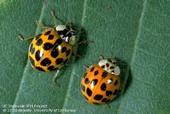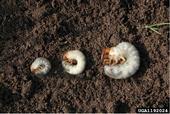- Author: Lauren Fordyce

Check out our webinars planned for summer 2024:
June 20, 2024 - Flea Control & Diseases: Starting from Scratch
Fleas are small but...
- Author: Lauren Fordyce

May is here and with all the fluctuations in our weather lately, there is a lot going on in the landscape! Follow these general tips for the month of May to prevent pests. To see more tips specific to your region, visit the Seasonal Landscape IPM Checklist on the UC IPM website.
- Look for the invasive Asian citrus psyllid on new citrus growth. If not known to occur in your area, report findings to your local county agricultural commissioner.
- Author: Lauren Fordyce

The multicolored Asian lady beetle, Harmonia axyridis, has a bad reputation. There is a common myth online that this lady beetle (ladybug) is invasive and aggressive, which can sometimes lead to people killing these beetles.
While this species of lady beetle was introduced to California from Asia in the 1990s to control aphid pests, it is not considered invasive. For an organism to be considered invasive it must be nonnative and cause harm to the environment, economy, or human health. Fortunately, the multicolored Asian lady beetle does not cause harm. Like many native lady beetle species, it feeds on pest insects like psyllids, scales, and especially aphids.
In the fall, multicolored...
- Author: Lauren Fordyce

While preparing your garden for planting this spring, you may have found white grubs in the soil. Discovering these fairly large, white grubs can be alarming, but they usually won't cause significant plant damage.
Grubs are the soil-dwelling larvae of beetles in the Scarabaeidae family, also simply called scarabs. They are generally curled in a C-shape with whitish bodies and 6 legs. Grubs of some species may be less than 0.5 inch long, while other species may be up to 2 inches. Some grubs feed on living plant material while others do not.
Masked chafer beetle grubs are often what people find in garden beds in California. If you find large grubs in compost, those are likely the larvae of the green...

Spring is here and if you are like us, you can't wait to get outside and see how your plants and garden are doing! As usual, UC IPM has useful tips for the month of April to prevent pests in the garden and landscape. To see more tips specific to your region, visit the Seasonal Landscape IPM Checklist on the UC IPM website. Here are some general tips to get you started:
- Cover fruit trees with netting to exclude birds and other vertebrate pests.


